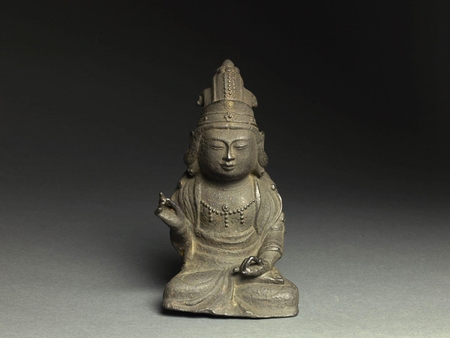Product Description
7096 An iron figure of a Kwanum (Kannon Bodhisattva) seated in the hanka (half lotus) posture. The right hand raised and the opposite hand rests on her left knee forming the an-i-in mudra with the middle fingers and the thumbs known as Lower Class: Middle Life.
Korea 17th /18th century Choson Dynasty
Dimensions: H. 8″ x W. 4¾” x D. 4″ (20cm x 29cm x 10cm)
There are six forms of the an-i-in mudra each representing one of the nine Esoteric Amidas, the so called Middle and Lower classes. The circle formed by the thumb and middle finger, a complete form, having neither beginning nor end, is that of perfection and resembles the Law of Buddha, which is perfect and eternal.
The hanka (half lotus) posture is formed by placing the right foot on the left thigh and symbolises the Right Way and the suppression of heterodoxy. This position also represents the Bodhisattva as the Victorious One, triumphant over the demons of evil, the universal sovereign who by spreading his Law represses the forces of malevolence.
Kannon Bodhisattva or Kannon Bosatsu is commonly known in English as the Goddess of Mercy represented as either male or female and depicted in many different forms and manifestations. Kannon’s worship originated in India during the 1st or 2nd century and later spread to the rest of Asia. Kannon is one of Asia’s most beloved deities and her worship remains non-denominational and widespread.
Kannon is a Bodhisattva and an active emanation of Amida Buddha, one who personifies compassion and achieves enlightenment but postpones Buddhahood until all can be saved. Her name first appears in the Lotus Sutra and means ‘One who Observes the Sounds of the World’. She can be worshipped independently as a saviour in almost all Buddhist sects including Esoteric Buddhism sects such as Zen, Nichiren, Tendai and Pure land Buddhism devoted to Amida.







